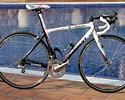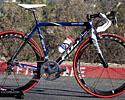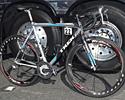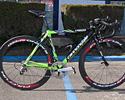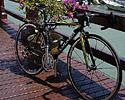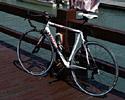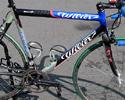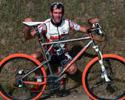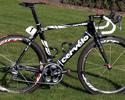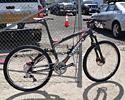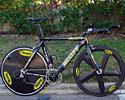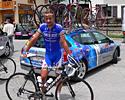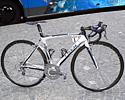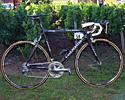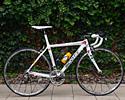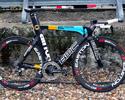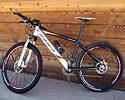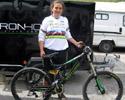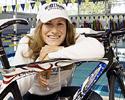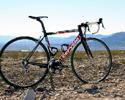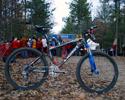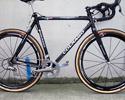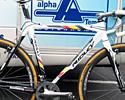
Recently on Cyclingnews.com |
2007 Pro Team bikes
This year's models
By the Cyclingnews technical team
Welcome to Cyclingnews' 2007 pro bike section; a look at what the professionals will be riding this season. During the 2007 year, we'll bring you a selection of images and specifications of the latest and hottest bikes.
Tom Boonen's Quick-Step Specialized TarmacSpecialized made a coup this winter, scooping up one of the biggest teams in cycling, Quick-Step. The Belgium-based squad had been using Time bikes over the past years but decided a change was due. The team, directed by Patrick Lefevere, boasts Peter Van Petegem, 2005 world champion Tom Boonen and current world champion Paolo Bettini. Boonen is a monster in the world of cycling and demands a bike that can withstand his thrashings. Specialized has supplied him several models to use for 2007; at home he has been on the Roubaix model while at the team's camp in late December he was given the Tarmac. |
|
Linus Gerdemann's T-Mobile Giant TCR Advanced Team ISPThe T-Mobile team has been riding Giant bikes ever since it switched from Pinarello at the end of 2003, and in that time the partnership has only continued to grow stronger. While the past few months have seen many changes to both riders and management, the relationship with the Taiwanese manufacturer continues to develop. In fact, the two agreed last September to a four-year extension on their existing sponsorship agreement, which now runs until 2010. This year, T-Mobile is emphasizing two philosophies for its ProTour set-up. The first is the importance of teamwork, and this is underlined by the printing in bold letters of the words 'Die Mannschaft' ('The Team') on the top tubes of the frames. Whether intentional or not, the credo's positioning near the stem means that when things really start to get tough in races and heads begin to drop, the fatiguing riders will have a visual reminder that they are part of a hard-working unit. |
|
Ivan Stevic's Fuji Toyota United Team IssueIn an innovative way to raise money last year, the successful domestic Continental team Toyota - United chose to forego a conventional bike sponsorship in favor of creating its own United bicycle brand developed in cooperation with Easton . However, sales of the bikes through the team's web site weren't what team owner Sean Tucker thought they could be. Therefore, Tucker abandoned his unconventional approach for 2007 and brought in well-established Fuji Bicycles to outfit the team with bikes for the new season, which the riders received when they gathered in Thousand Oaks, California this past January. "We really needed distribution," he said. "It was something we lacked last year. Fuji has dealers all over the world." Head mechanic Shane Fenon says that the United Team Issue Fuji uses Fuji's Carbon C7 frame and is equipped with a unique Shimano and Bontrager build specification that differs from Fuji's standard Team Issue. "The Team Issue is our mainstay frame," Fenon said as he prepped Ivan Stevic's bike for a long training ride in Thousand Oaks. "We also have the SL-1; a lighter frame we use specifically for our climbers." |
|
Ivan Basso's Discovery Channel Trek Madone SSL 6.9Discovery Channel Pro Cycling Team held its preseason training camp in the picturesque region surrounding Solvang, California, partially in preparation for this year's Tour of California. Unlike the December 'social' camp in Austin, TX, the Solvang camp found the boys logging long hours test riding their new 2007 race bikes. It's a little of every cyclist's fantasy to open a gift like the Trek Madone SSL 6.9; after all, Lance Armstrong won the Tour de France seven times on a Trek carbon frame, and there is no exception for Discovery Channel's Ivan Basso. "I think the Trek is one of the best bikes in the world," Basso said in comparison to the Cervélo Soloist and R3 Carbon bikes he used last year with Team CSC. However, Basso is wisely careful not to knock his past sponsors, adding, "But I think that both the Trek and the Cervélo are the best in the world so it is difficult for me to find big differences in the way they handle. The feeling of my Madone is very similar to the Cervélo I used last year." |
|
Juan Jose Haedo's Team CSC Cervélo Soloist CarbonAfter a fruitful stay racing domestically in the US with the Toyota-United Pro Cycling Team, Juan José (or J.J. as he is better known) Haedo made the jump to racing in Europe with Team CSC. Haedo first caught the eye of Team CSC director Bjarne Riis after winning two stage wins at the 2006 Tour of California, and now joins a star-studded cast as the team's first pure sprinter making his team debut at the same race which was arguably responsible for bringing him into the limelight. With the new team comes new sponsorship, and Haedo has swapped last year's aluminum and carbon United frame for a full-carbon Cervélo Soloist Carbon, winner of our Reader Poll this year for 'Best Team Bike'. Visually speaking, the frame's dramatically deep aerodynamic tube sections are what immediately draw the eye. However, while the ability to efficiently slice through the air certainly can't hurt as Haedo makes for the finish line, aero tube profiles are not at the top of his list of priorities when it comes to equipment. |
|
Luca Paolini's Liquigas Cannondale System SixAs compared to the rather international nature of most ProTour teams these days, the Liquigas team is somewhat of a standout being decidedly Italy-centric is nearly all respects. The team retains a nearly 100% Italian roster as well as a panoply of like-oriented sponsors, including nearly all of its clothing and equipment, its team cars, and even the pasta and coffee the team eats and drinks. This year, though, Liquigas has traded the trademark celeste green colors of its former Italian bicycle sponsor, Bianchi, for the distinctly red, white, and blue hues of US-based Cannondale. Cannondale has supplied the team with both its carbon fiber and aluminum System Six as well as the full carbon Synapse. Team Liaison Rory Mason stated that most of the team will opt for the somewhat cushier Synapse when it comes time to ride the cobbles in the Spring classics, but the majority of the team usually chooses the edgier System Six otherwise, including one-day specialist Luca Paolini. |
|
Salvatore Commesso's Tinkoff Credit Systems Colnago Dream HX
"Someone was born to invent automobiles, or to build airplanes or ships, or to write poetry or be a surgeon or a teacher. Ernesto Colnago came into the world to build bicycles. It is, for Colnago, a natural gift. Every part of the most popular vehicle invented by man is treated by Colnago with the delicacy and precision of a diamond cutter." Few would argue with this statement, which appears on the homepage of the Colnago Web site and is headlined "Quality Is The Soul Of Our Product". Bearing the mark of a three-leaved clover, Colnago was once a brand name most could only dream about owning, but in recent years, the Cambiago, Italy, based firm has expanded its range, and while the top models - including Salvatore Commesso's Dream HX - are still made in Italia, part of the production is now outsourced and made in China. |
|
Laurent Lefevre's Bouygues Telecom Time VXR ProteamUsed as a working prototype last year by riders like Tom Boonen and Paolo Bettini, Time's new-for-2007 model VXR Proteam weighs around 70 grams more than the flagship VXRS Ulteam, but is designed to be a little more robust. Time claims the new frame is still sub-1kg (985 grams +/- 5 percent), and for Laurent Lefevre and the rest of his Bouygues Telecom équipe, that is still light enough to qualify the VXR Proteam as a second race-worthy bike to be used alongside the VXRS Ulteam. Time integrates a polyamide fibre braid it calls Vibraser into the top and bottom of the carbon tubes, the leading and trailing edges of the fork blades, the top and bottom of the stem, and front and back of the seat post. According to Time, this allows for controlled flex in one direction and engineered rigidity in the other. The aim is to produce an entire 'module' (consisting of the frame, fork, seat post, and stem) remain incredibly stiff laterally but compliant along the plane of the bike. |
|
Adam Craig's Team Giant Anthem AdvancedTeam Giant rider Adam Craig played a key role in developing Giant's dedicated short-travel Anthem XC-racing platform two years ago, and has been heading straight down the dual-suspension path since then with virtually no looking back. At the first major MTB test of 2007 on U.S. soil here in Fountain Hills, AZ, Craig opted to use his Anthem for each stage save only for the twilight short track event that was held downtown on a mix of pavement and dirt. "I can ride a hardtail as fast in almost all situations, but it would take so much more effort," stated Craig. "If I were to put that much effort into riding a dualie, I'd end up going a teeny bit faster in a much more relaxed and much more composed manner. We're fortunate enough to have a super efficient suspension design that gives you faster rolling over all of the square-edged stuff because of the axle path and it just generally facilitates riding fast." |
|
Alessandro Ballan's Lampre-Fondital Wilier Le RoiFresh off a morning training ride, Alessandro Ballan's Lampre-Fondital Wilier Le Roi was basking in the warmth of the Belgian spring sunshine. His Sigma computer read 69 kilometres (43 miles) but the Le Roi frame looked like it wanted (and was ready for) much more. Just one day before we spotted it outside the Kennedy Hotel in Kortrijk, Belgium, Ballan's machine had delivered the 27 year-old to glory in the Three Days of De Panne where he escaped with compatriot Luca Paolini in Stage 1. Ballan used his Wilier machine to hold on for second place that day, but then took the overall win two days later, securing him as one of the favourites for Sunday's Ronde van Vlaanderen. Produced in Bassano del Grappa, the Wilier Le Roi frame has been around a few seasons and is well respected by the boys in the Italian squad. Wilier used individual Mizuno carbon tubes and tube-to-tube construction for the Le Roi last year, but has swapped to monocoque construction for 2007. |
|
Geoff Kabush's Team Maxxis Litespeed Sewanee LSTeam Maxxis has switched bicycle sponsors for the 2007 season from Turner Bicycles to a new joint sponsorship arrangement. The team's gravity racers will run longer-travel machines from Ellsworth, but cross country stars Geoff Kabush and teammate Mathieu Toulouse will both campaign the season aboard dedicated titanium cross country machines from Litespeed. Kabush cleaned house at the first MTB Nationals race of the 2007 season, winning both the cross country and short track races in consecutive days, and has been somewhat of a trendsetter in the pro field in years past with his preference for full suspension bicycles. Even with the new sponsorship agreement, things haven't changed much. |
|
Frank Schleck's CSC Cervélo SLC-SLFrank Schleck lined out at the start of Amstel Gold as the defending champion, and was highly motivated to defend his title in the ProTour event. Although the CSC rider crashed during the race and lost a lot of time, he remounted, successfully chased back on to the bunch and finished tenth. That energy expenditure doubtlessly cost him on the tough finale, but the final result confirmed he was in top form. Schleck was suffering from badly bruised ribs in the days after the crash but nevertheless finished seventh in Fléche Wallonne, just 16 seconds behind winner Davide Rebellin. |
|
Liam Killeen's Team Specialized S-Works Epic CarbonOne could say that second-year Team Specialized rider Liam Killeen has a bit of a weight problem… at least as far as his bike is concerned. Like so many top-level mountain bike racers these days, Killeen races on a full-suspension machine for its bump absorption, fatigue, and traction benefits. However, he is under no false impression that those competitive performance advantages also carry with them a distinct disadvantage on the gram scale. While quite lightweight at approximately 2.3kg (5.07lb), Killeen's S-Works Epic Carbon still typically gives up 1kg (2.2lb) or more over competitors that opt for a hardtail on race day. "The most important thing is trying to get the weight down," said Team Specialized mechanic Benno Welliet. "Other guys are riding a hardtail, and just to get close to them, we try everything to get the weight down. But it's also performing better because it's a full suspension bike." |
|
Sylvain Calzati's Ag2r Prévoyance bTwin FC700Fifth year pro Sylvain Calzati relied on the bTwin Full Composite 700 (FC 700) to get him through the 93rd Liège-Bastogne-Liège. Things didn't go quite as well as the 25 year-old rider had hoped as he finished 15 minutes down on winner Danilo Di Luca, but perhaps he was thinking more of the upcoming Tour de France where he put his name (and the name of bTwin) into the lights with a solo victory during last year's stage 8 to Lorient. The bike that he used on that day was much the same as the one he is using in the early part of 2007. France-based bTwin is better known for its production of non-racing bikes but has been in the game for some time nevertheless. In fact, parent company Decathlon was the official bicycle supplier of Ag2r back in 2005. What catches the eye immediately on the FC700 is the hard-edged industrial styling of the carbon fiber tubes and the bulbous juncture of the seat tube and top tube. bTwin uses T700 high modulus fibres to impart stiffness to its top-end machine but also a healthy dose of Kevlar fibres to absorb vibrations. |
|
José Rujano's Unibet.com Canyon Ultimate AlAt just 1.62m (5'4") tall, 25 year-old Venezuelan José Rujano usually puts more effort into adding weight on to his bike to meet the minimum UCI weight limit than he does trying to shave every possible gram. When we weighed Rujano's teeny-weeny Canyon Ultimate Al back at the start of the ninth stage of the Tour de Langkawi in Putrajaya, it was smack-bang at 6.8 kilos, so the Unibet.com mechanics obviously made a few 'adjustments' to make it race legal. While the climbing specialist wisely chooses the feathery 975g per pair Lightweight Obermayer wheels, other equipment picks are decidedly more conventional. Rujano's aluminum Ultimate Al frame incorporates some complex shaping and the same tapered and oversized front end as on Canyon's other top-end models, but still gives up roughly 350g as compared to the decidedly fancier carbon fiber Ultimate CF. |
|
Gilberto Simoni's Saunier Duval-Prodir Scott Addict LimitedGiven that their success depends on their ability to overcome gravity, it is perhaps unsurprising that climbers are a weight-obsessed breed. Whether is it on the bike itself or around the ribs, keeping the grams down is conducive to success. That trait is plainly evident if you take a look at a specialised climber. As compared to your typically bigger and burlier (relatively speaking, of course) Classics rider, those who scrap it out in the Alps, Pyrenees and Dolomites are generally a slighter, skinnier, and often smaller, individual. Even with recent all-rounders such as Lance Armstrong and Jan Ullrich, hitting a low body fat prior to the Tour was essential for their chances. |
|
Sergey Lagutin's Navigators Insurance Colnago C-50At just 26 years-old, Navigators Insurance Pro Cycling rider Sergey Lagutin already packs a seriously fast finish: he is currently the Uzbekistan national road champion and also scored the 2003 U-23 World Championship in Hamilton with just a single teammate by his side. After starting his professional career with the Belgium-based Landbouwkrediet - Colnago team in 2004, Lagutin now finds himself in his second season with the Navigators Insurance Pro Cycling Team. Although the team is based in the USA, the Navigators still spend plenty of time in Europe where Lagutin recently won the first stage of the International Rheinland-Pfalz Rundfahrt among a heavily ProTour-laden peloton. The Navigators have been sponsored by Colnago for a number of years now, and for 2007 the team's race bike is the company's iconic C50. Interestingly, although the Navigators is a US team, its race machine is a nearly 100% Italian affair. The majority of the drivetrain parts are top-shelf Record bits from Campagnolo who also supplies the deep section, but very lightweight, Bora Ultra wheelset. Continental provides the Competition 22mm tubular tires, which happened to hold air pressure amazing well for sew-ups as discovered during the course of a seven day tour. |
|
Robbie McEwen's Predictor-Lotto Ridley NoahWhile Robbie McEwen is very much a born and bred Aussie, he has integrated well into Belgian culture and has a strong fan base there. He speaks the lingo, spends a lot of time in the country and, importantly, is a very successful bike rider, which is always a good thing for the cycling-mad Flemish. Moreover, the 34-year-old races for the Belgian Predictor-Lotto team and also rides a Belgian bike, the Ridley Noah. McEwen debuted the new machine at last year's Tour de France and wasted no time in racking up a few victories, including three stage wins and his third maillot vert there, as well as victory in Paris-Brussels later that year. |
|
David Millar's Saunier Duval-Prodir Scott CR1 Plasma TTAfter completing a two-year suspension for a doping violation and being subsequently fired by his long-time Cofidis team, Scottish time trial specialist David Millar returned to the pro peloton in 2006 with a new Saunier Duval-Prodir team, a new Scott Plasma time trial bike, and a new attitude on his illustrious career. Millar fully expected last season to be more of a time to get back into the swing of things than an opportunity to aim for the top step on the podium again, but perhaps even he was surprised at how well, and how quickly, things progressed. After a lackluster (for him, that is) Tour de France return that saw a 17th place finish on the opening prologue and 11th place spot on the second individual time trial, the 2000 prologue winner bounced back with a fantastic win at the 33km Stage 14 time trial of that year’s Vuelta a España only to add a British National Individual Pursuit title as well later that fall. Millar continued his momentum this season with a prologue win at Paris-Nice and he’s already displaying solid form at the Critérium du Dauphiné Libéré. |
|
Tom Boonen's Quickstep-Innergetic Specialized S-Works Tarmac SL2We're only into the middle of the 2007 season, but Quickstep-Innergetic superstar Tom Boonen is already on his third frame model since his team switched its bike sponsor last year from Time to Specialized. Boonen started out on a relatively off-the-shelf S-Works Tarmac SL that the company beefed up a bit with some additional carbon plies to better handle his power output. That frame was apparently good in terms of overall stiffness and comfort, but its slightly shorter cockpit dimensions relative to what Boonen was accustomed to proved to be a bit much for his back to handle. Boonen has always run his bikes on the long side in terms of handlebar reach not only for his rangy 1.92m (6' 4") height, but also to accommodate his decidedly aggressive positioning. The fit of his bike has now become an even higher priority than before given his recent back issues. Boonen never really settled in on the geometry of his new extra-large Tarmac SL, and switching frame sizes was not a viable option. |
|
Levi Leipheimer's Discovery Channel Trek MadoneLevi Leipheimer started off this season with a bang, winning the Tour of California in grand fashion by leading the race from start to finish, and rarely appearing to be in much difficulty. Later on at the Critérium du Dauphiné Libéré, however, Leipheimer kept within striking distance for most of the race but stomach ailments caused him to lose more than fourteen minutes on the hilly Stage 6 to Valloire. The defending champion sought to at least pull out a win on the final stage the next day with what appeared to be a successful late breakaway but an unfortunate crash while crossing a rain-slicked roundabout less than 4km from the finish ended his chances on the day. With Ivan Basso now officially out of the picture as a result of his involvement with the Operación Puerto scandal, though, Leipheimer is now the undisputed leader of the team for the upcoming Tour de France. Leipheimer's Critérium du Dauphiné Libéré TdF warmup may not have gone quite as planned but he has still displayed solid form heading into the critical month of July, and team sponsor Trek has provided additional support in the form of all-new Madones. |
|
Fabian Cancellara's Team CSC Cervélo SLC-SL
Team CSC continues its winning ways and has started off this year's Tour de France with a bang. Current world time trial champion Fabian Cancellara was the only rider to complete the opening prologue in less than nine minutes, averaging a blistering 53.7km/h (33.4mph) over the flat 7.9km (4.9mi) course through the streets of London and taking the first maillot jaune in the process. After the Swiss speedster proved himself as one of the best trialists in the world yet again, he reminded the rest of the peloton that he is a threat on the road as well (as if his 2006 win at Paris-Roubaix wasn't enough). Stage 3 looked to finish in a bunch sprint, but Cancellara had other plans: he gave it full gas at a relatively long 750m to go and held off the charging pack of pure sprinters to take the win in spectacular fashion… with his hands on the hoods. |
|
Michael Rasmussen's Rabobank Colnago Extreme-C
Danish Rabobank rider Michael Rasmussen is having what is perhaps the best Tour de France of his career. After breaking away early in Stage 8, the two-time maillot à pois rouges winner shed his companions with 18km remaining and rode alone into the finish at Tignes to take the victory for the day as well as his first maillot jaune. 'The Chicken from Tølløse' had previously won two mountain stages, first in Mulhouse two years ago, and then at La Toussuire in 2006. As one of the ProTour's most renowned climbing specialists, Rasmussen is likely more aware than most of the key to victory in the big mountains: maximizing power-to-weight ratio. Rasmussen certainly pays plenty of attention to the first half of that equation but is decidedly better known for his passionate fervor about the second half. Rasmussen himself stands 1.75m tall (5'9") but weighs just 60kg (132lb). |
|
Iban Mayo's Saunier Duval-Prodir Scott Addict Limited
Basque climbing sensation Iban Mayo has certainly had more than his fair share of ups and downs during his career, both literally and figuratively. Mayo was a revelation in the 2003 Critérium du Dauphiné Libéré, captured a glorious Tour de France stage victory atop l'Alpe d'Huez shortly afterwards, then dominated over Lance Armstrong in the Critérium du Dauphiné Libéré the following year. Sadly, though, his performance mysteriously faltered in spectacular fashion since then yet he has remained at the forefront of the sport, at least in terms of expectations. After six seasons with the Euskaltel-Euskadi team, Mayo made what has proven to be a reinvigorating move to Saunier Duval-Prodir for 2007 and has barely looked back since then. The change in scenery apparently removed much of the homegrown pressure to perform and allowed the enigmatic personality to clear his head and refocus his efforts on being one of cycling's best ascenders. |
|
Paolo Savoldelli's BMC TT01 Time Machine
Team Astana rider Paolo Savoldelli's BMC TT01 Time Machine doesn't travel through time like the fictional H.G. Wells' apparatus, but it is certainly designed to shave as much time as possible from the clock as it slices through the air. BMC first unveiled its creation under the legs of Tyler Hamilton back at the 2004 Tour de France, yet in spite of its relative age, it still stands as one of the most radical examples of the genre today. Naturally, aerodynamics are a key factor with any dedicated time trial rig, and BMC shapes each applicable tube into a deep airfoil section that takes maximum advantage of the UCI's 3:1 aspect ratio rule. Moreover, its unique Aero Hinge design incorporates a proprietary fork, headset, and stem construct that is claimed to be lighter, stiffer, and more aerodynamic than conventional setups. |
|
Bradley Wiggins' Cofidis Time VXRS Ulteam World Team
While most riders in the Tour de France were heading for this year's prologue in London, Cofidis rider Bradley Wiggins was simply returning home. Wiggins had high expectations for this year's prologue as the course passed directly through well-familiar stomping grounds, and the short 7.9km length and flat parcours seemed ideally suited to the current World and Olympic World Champion. Wiggins blazed past Buckingham Palace just three spots shy of his ultimate goal, but still among the top finishers in fourth position. Two weeks later in the significantly longer and hillier Stage 13 time trial in Albi, he posted an early best time in the decidedly dicey conditions and looked to hold on for the win, but steadily improving conditions thwarted his morning efforts. While he confirmed his solid form, Wiggins ended up with another top-five placing instead of the win. |
|
Nat Ross' Subaru-Gary Fisher Gary Fisher HiFi 29
Twenty-four-hour endurance racing is a burgeoning segment of the competitive mountain bike scene on both the amateur and professional fronts, but Nat Ross is still among a select few who have managed to achieve true notoriety as a specialist in the discipline. 2007 will mark the Subaru-Gary Fisher veteran's seventh season with the team, racking up the 2006 US 24 Hour Solo National Series championship and winning the 24 Hours of Moab, Landahl, and Temecula in the process, along with numerous podium finishes throughout his career. "I've been doing these races since '98 and I'm on my 33rd or 34th 24 hour solo race," said Ross. "The coolest thing for me now is to explore new venues, do new races, and get some different experiences other than the same loop year after year." |
|
Julien Absalon's Team Orbea Orbea Alma
Olympian and defending world champion Julien Absalon will put his Orbea Alma to the test this weekend against the world's most celebrated field of mountain bikers at the Mountain Bike World Championships in Fort William, Scotland. Now nearing the end of his first season with Orbea, Absalon has already amassed repeat victories for his sponsor including the French National XC championship, French Cup, and UCI World Cup XC championship. Next up, Absalon has targeted a fourth, consecutive world title and another Olympic medal that is within reach just beyond the horizon at the Games next year in Beijing. As if in anticipation of things to come, Julien Absalon's blue team Orbea tent was conveniently located closest to the podium back in July at the French National Mountain Bike Championships. That made sense since race-favorite Absalon was expected to share the podium with teammate Jean-Christophe Peraud. When both Absalon and Peraud delivered first and third place, respectively, the shorter trip to the awards stage created less opportunity for both stars to get mobbed by adoring fans. |
|
Sabrina Jonnier's Team Iron Horse/Monster Energy Iron Horse Sunday World Cup
Starting Thursday, September 6, defending world downhill champion Sabrina Jonnier will need to figure out the fastest way from the top to the bottom of the championship course at Fort William, Scotland. Jonnier will need to outwit, outhandle, and outsprint the competition, which will Tracy Moseley and Rachel Atherton, both of whom will be racing in their home country on a course upon which Jonnier has never won. To win the world title is one thing, but to defend is quite another - this is something Jonnier knows for a fact. Her training program has been crafted around the world championships and when the moment arrives for her to lower her helmet and take her position at the starting gate, she will throw her leg over her Iron Horse Sunday World Cup and take command of her hardest race of the season. |
|
Mara Abbott's Webcor Orbea Orca Special Edition
First-year Webcor rider Mara Abbott has had a fairy tale season in 2007. In only two short years of racing, Abbott has scored four collegiate US national championships, the U23 time trial championship, the overall victory at this year's Tour of the Gila stage race, and podium finishes at the Redlands Classic, Montreal World Cup and the Nature Valley Grand Prix. Most recently, Abbott surprised even herself by out sprinting Kristin Armstrong to the line to land the 2007 US National Elite Women's Road Championship. With those sorts of results, one would expect Abbott to be a well-seasoned cyclist with years of racing under her belt, but surprisingly, that couldn't be further from the truth. Abbott has been a competitive freestyle distance swimmer since the age of nine, and continues to compete on the collegiate level for Whitman College in Walla Walla, Washington where she is currently finishing out her senior year. Abbott began road racing only during her freshman year (mostly on a whim), but her meteoric rise up the ranks and quick collection of race wins and podium finishes earned her a trip to a women's training camp at the United States Olympic training center in Colorado Springs and a first-time meeting with her now-coach Michael Engleman. |
|
Stuart O'Grady's Paris Roubaix winning Cervélo R3
What on earth? Another 'pro bike' article in the midst of Interbike coverage? And one on a bike that hasn't seen the light of day since April no less? Surely you jest. Unfortunately, that's precisely how long it's taken us to track down Team CSC rider Stuart O'Grady and the Cervélo R3 that he used to score Australia's first-ever Paris-Roubaix win (as well as a repeat win for the team). On that fateful day, O'Grady spent 240km as part of a 30-plus man breakaway, but then cunningly launched his own solo attack at just over 20km to go. As his sweet reward, O'Grady rolled into the Roubaix velodrome alone with nothing behind him but glory and adulation, a full 52 seconds ahead of his closest rival, Juan Antonio Flecha (Rabobank). For sure, a win like that is fully earned by the rider pushing the pedals, but O'Grady's Cervélo R3 didn't exactly hamper his effort. Created as a special build just for that day, the R3's chain stays are 1cm longer than normal to provide more mud clearance, and the matching Alpha Q GS-10 fork wears a bigger 50mm rake to maintain similar weight distribution as on the standard geometry R3. In addition to providing more mud clearance, the extended dimensions also provide a longer wheelbase for a slightly more stable ride over the undulating cobbles. Otherwise, according to Cervélo principal Gerard Vroomen, O'Grady's frame was essentially an off-the-shelf R3. |
|
Ned Overend's Specialized S-Works Epic
Living mountain bike legend Ned Overend continues to defy the laws of time. At 52 years of age, the Durango, Colorado resident landed a sixth place finish in the Pro Men field at the Iceman Cometh, an end-of-season 43.5km (27mi) point-to-point classic in northern lower Michigan whose perpetually rolling terrain doesn't particularly cater to the former world champion's strengths. In addition, much of the course is laid out on relatively wide-open doubletrack, paving the way for road race-like speeds and even road race-like tactics, such as double- and single pacelines. "Oh, man [laughs], it started fast," he said. "I mean it was wound up right from the beginning, and there were times when I wasn't on, because I was on the rivet from the gun, and then I finally get back on and started to recover a bit, and then guys were coming off. There were probably about ten of us. Guys would come off, and then I would close the gap. For a while in there, I thought I might have been ok, but then my legs were loaded up. They weren't recovering from all of the speed. The short hills were hurting me; they weren't doing me any good. I thought I might have been better, but the hills weren't long enough. I came off with about five or six miles to go… that was a long five or six miles! [laughs]" Even though Specialized's newest Stumpjumper FSR could easily be called Overend's signature machine, he still chose the more race-oriented Epic for the non-technically demanding terrain. "I don't race the Stumpjumper; I always race the Epic," said Overend. "It's just got more of a race position, more handlebar drop. I still race on flat handlebars and bar ends!" |
|
Jonathan Page's Sunweb-Projob Ridley X-Night
Cyclo-crosser Jonathan Page had the day of his life last January when he won the silver medal at the 2007 World Championships in Hooglede-Gits, Belgium, the best finish ever by a US male elite racer in that discipline. Some have argued that he was merely lucky that day, as earlier crashes ended the hopes of favorites Sven Nys (Bel) and Bart Wellens (Bel). However, years of hard work on the part of Page, as well as an unparalleled commitment to the discipline, would tend to suggest that this was merely a natural progression of events, not a fluke. Page and his family are now spending their fifth consecutive winter in their home just outside of Gent, and now consider themselves residents of Belgium since they spend more time there than in the US. Not surprisingly, the transition has not always been smooth, and adapting to the area's cyclo-cross-mad atmosphere has presented its fair share of challenges. "It's not easy," he said. "The culture here is much different [from the US]. I don't want to have to fight everything. It's all fine if you get good results, but when you're not riding well, everything's a problem." Still, though, immersing himself in the lion's den has paid its dividends and helps to explain Page's progression over the past few years. "It's gotten my level up, and that's why I moved here. I've learned a lot, and now I'm trying to get good results. There's a lot more depth in the field here, and it makes you… it breaks you really." |
|
Katie Compton's Spike Shooter Primus Mootry
Katie Compton (Spike Shooter) stunned the cyclo-cross world in 2004 when she won her first of what would eventually be three consecutive US national championships (2004, 2005, 2006). At the time, she seemingly came out of nowhere since her double life as a captain on a Paralympic track tandem team prevented her from participating in most key events. Now with those other obligations behind her, Compton has since dedicated herself fully to the discipline of 'cross and hasn't looked back since. She scored a silver medal at the 2007 Cyclo-cross World Championships in Hooglede-Gits, Belgium after competing in only one UCI World Cup event beforehand, and has now just won her first UCI World Cup event in Pijnacker, Netherlands last weekend. Compton's powerful physique and aggressive riding style have certainly suited the 29 year-old Colorado Springs, Colorado resident well. "It's been a slow progression," says her manager/mechanic/husband (among other things!), Mark Legg. "Basically she's been tandem racing with the Paralympics. When you're dragging around a rider on the back, you just bury yourself and it makes you strong like an ox. She also grew up in Delaware riding singlespeed with a lot of her friends, and just trying to keep up with them made her into this really, really good bike rider in terms of handling skills." |
|
Todd Wells' GT GTR CX
Todd Wells is officially paid to ride and race mountain bikes by his team sponsor, GT Bicycles, and does an excellent job at it: he's a former US national champion in short track, a two-time collegiate US national champion, and as one of the most consistent performers on the US national circuit, Wells represented his country at the 2004 Olympic Games in Athens, Greece. As if that weren't enough, Wells is also equally accomplished on in cyclo-cross with an additional pair of US national titles there, too. According to his mechanic, Doug Hatfield, "[The mountain bike is] what he's paid to race, but he loves [cyclo-cross]; it's in his heart. It's fun for him and it's good conditioning in the winter. Back in the tradition, cyclo-cross was your off-season sport, but now it's become such a big mainstream sport and he does well in it as well." "I started racing cross in '01 just because I love racing and it's something different," Wells said. "I really enjoy racing 'cross, though, and have been stoked to see its growth over the last six years. Personally I find 'cross more exciting to race then mountain bikes but I love racing and riding mountain bikes also." |
|
Bradley Wiggins' & Mark Cavendish's track machines
As members of the Cofidis and T-Mobile teams, Bradley Wiggins and Mark Cavendish ordinarily ride Time and Giant bikes respectively on the road (we featured Wiggins' Time VXRS Ulteam back in the summer, and we currently have an actual one of Cavendish's Giant TCRs on our test bench). On the track though, they ride altogether different machines, and Cyclingnews' Ben Atkins squeezed into their Rennerszone at the recent Gent Six-Days to check them out. Terry Dolan has been building frames at his facility in Merseyside, England since the 1970s, having been taught the craft by celebrated Liverpool framebuilder Harry Quinn. Although most of his production is now made up of carbon monocoques and off-the-peg frames made overseas, the company still produces around four custom bespoke frames a week which is where Dolan's passion really lies. Over the years, his bikes have won over 300 national championships (mostly on the track), and Dolan has developed long-term relationships with world champions like Chris Boardman and Yvonne MacGregor. He has also worked with the Great Britain national track squad since 1988, and the team - including ProTour riders Wiggins and Cavendish - now rides his frames in events where they don't have the use of their UK Sport carbon fibre ones. Click here for full details on Wiggins' & Cavendish's bikes. |
|
Sven Nys' Colnago C50 Cross
Sven Nys is one of the most decorated cyclo-cross riders currently on the circuit: the 31-year-old Belgian has won seven Superprestige trophies, two World Cups and the 2005 World Championships, and recently went on to win the World Cup round in Koksijde, Belgium moments after Cyclingnews had a look at the Colnago that carried him to victory. The Italian-made frame is labeled as a standard Colnago C50 Cross. However, unlike the production model that is actually designed to be somewhat softer than its road-going counterpart, the reinforced tubing and construction on Nys' bike make it more akin to the company's markedly stiffer Extreme Power. "It says C50, but that is not right because it is actually an Extreme Power," said Nys. "In the beginning when we had the carbon frame it was not strong enough. However, the one we have now is great for cyclo-cross because the sprints are zero-to-40, and you need a strong bike." |
|
Tim Johnson's Cannondale-Leer-Cyclocrossworld.com Cannondale XTJ & Lyne Bessette's Cyclocrossworld.com Ridley X-Fire
ust as in the world of auto racing, one umbrella sponsor can support several teams of different names. In the world of cyclo-cross, online retailer and news portal Cyclocrossworld.com is that umbrella with its sponsorship of the Cannondale-Leer-Cyclocrossworld.com team of Tim Johnson and the Cyclocrossworld.com squad of Lyne Bessette and Jeremy Powers. Johnson competes aboard his own signature bike, the Cannondale XTJ, while Bessette and Powers both utilize Ridley's latest 'cross creation, the X-Fire. Ridley slots the X-Fire in between its already successful carbon fiber X-Night and aluminum/carbon Supercross frames, and doesn't appear to have skimped much on the performance. The smooth, organic lines of the X-Fire stands in sharp contrast to the 'Sharp Edge Design' that characterizes its bigger brother (and the road going Noah), but its monocoque carbon fiber construction still tips the scales at a competitive 1.32kg. Ridley's own 4ZA monocoque carbon 'cross fork completes the front end. Click here for full details on Tim Johnson's & Lyne Bessette's bikes. |
|
Bart Wellens' Team Fidea Ridley X-Night
Bart Wellens is among cyclo-cross racing's elite tier with two World Championship titles and three Belgian Championships to his name. The 29 year-old Fidea rider has raced on Ridley's all-carbon X-Night model since at least early 2004 but was seen on a brand-new version of the Belgian company's top 'cross offering at the World Cup round in Koksijde, Belgium. The new model is still all-carbon but wears a slightly softer look overall as well as a newly integrated seatmast capped by a polished aluminum head. "New for this season is a monocoque frame, with an integrated seat post. This is a new model for 2008," said team mechanic Joris Vinex. "This year, with the monocoque... well, it is different. We need to saw off the integrated seatpost, and we will see how to the frame holds up over the years." |


